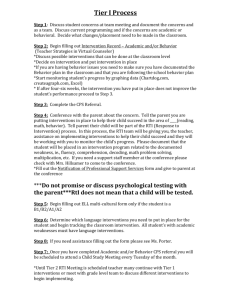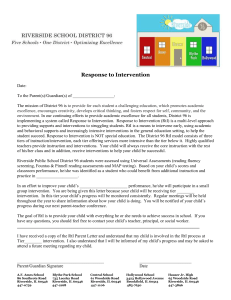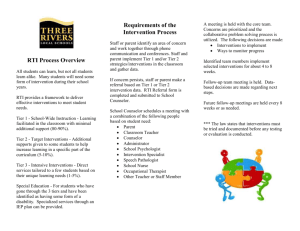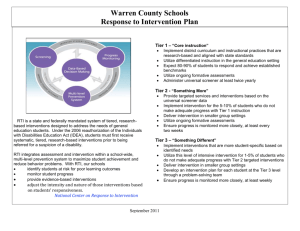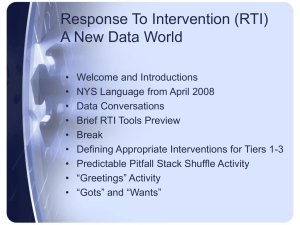RTI Is
advertisement
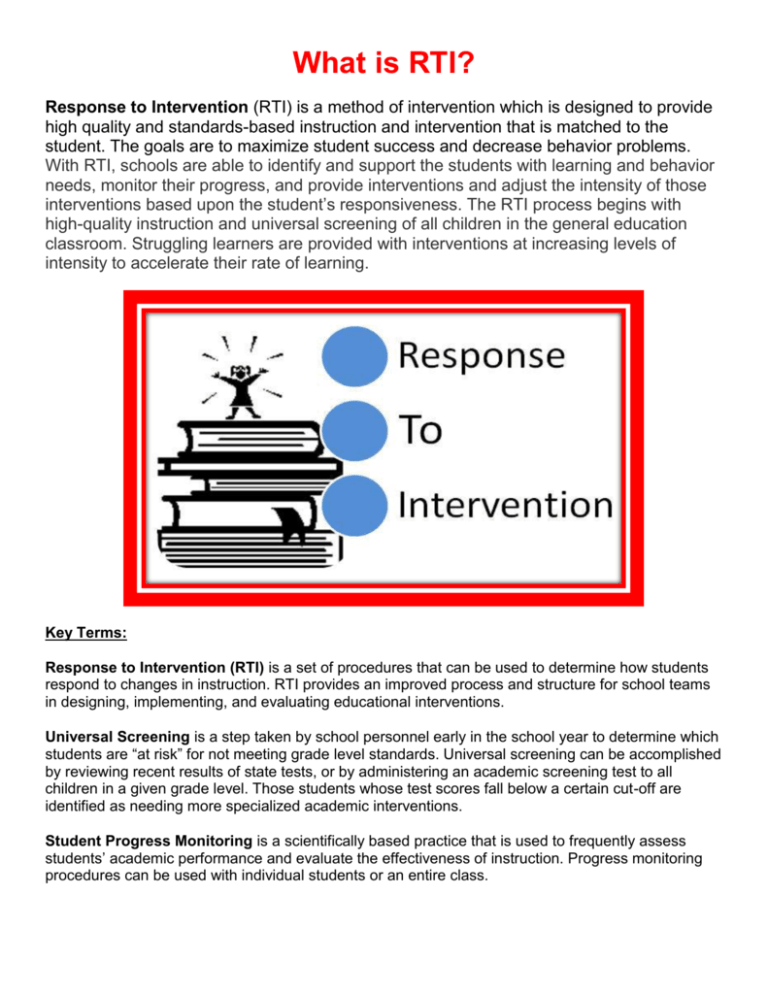
What is RTI? Response to Intervention (RTI) is a method of intervention which is designed to provide high quality and standards-based instruction and intervention that is matched to the student. The goals are to maximize student success and decrease behavior problems. With RTI, schools are able to identify and support the students with learning and behavior needs, monitor their progress, and provide interventions and adjust the intensity of those interventions based upon the student’s responsiveness. The RTI process begins with high-quality instruction and universal screening of all children in the general education classroom. Struggling learners are provided with interventions at increasing levels of intensity to accelerate their rate of learning. Key Terms: Response to Intervention (RTI) is a set of procedures that can be used to determine how students respond to changes in instruction. RTI provides an improved process and structure for school teams in designing, implementing, and evaluating educational interventions. Universal Screening is a step taken by school personnel early in the school year to determine which students are “at risk” for not meeting grade level standards. Universal screening can be accomplished by reviewing recent results of state tests, or by administering an academic screening test to all children in a given grade level. Those students whose test scores fall below a certain cut-off are identified as needing more specialized academic interventions. Student Progress Monitoring is a scientifically based practice that is used to frequently assess students’ academic performance and evaluate the effectiveness of instruction. Progress monitoring procedures can be used with individual students or an entire class. Scientific, Research-Based Instruction refers to specific curriculum and educational interventions that have been proven to be effective –that is, the research has been reported in scientific, peerreviewed journals. The multi-tiered approach has three levels of intensity which are coordinated to student needs based upon research-based interventions. The three levels of intervention include the universal, supplemental, and intensive tiers. The universal tier (Tier 1) is comprised of 80-90% of the student population. Tier 1 includes high quality core instruction. Tier 2 is the supplemental tier and includes 5-15% of the student population. This tier includes evidence-based interventions of moderate intensity. Tier 3 of the model is the intensive tier that that is comprised of 1-5% of the student population. The intensive tier’s prevention level includes individualized interventions of increased intensity for students who show minimal response to tier two preventions. RTI Common Beliefs All children can learn and achieve high standards as a result of effective teaching. All students must have access to a rigorous, standards-based curriculum and researchedbased instruction. Intervening at the earliest indication of need is necessary for student success. A comprehensive system of tiered interventions is essential for addressing the full range of student needs. Collaboration among educators, families and community members is the foundation for effective problem-solving and instructional decision making. On-going and meaningful involvement of families increases student success. All members of the school community must continue to gain knowledge and develop expertise in order to build capacity and sustainability of RtI. Effective leadership at all levels is crucial for the implementation of RtI. Positive School Climate and Culture: A positive school climate is observed when key elements are solidly in place. Defining and consistently teaching expectations of behavior for students, parents and educators; Students and adults are acknowledged and recognized consistently for appropriate behaviors; Behavioral and instructional errors are monitored, corrected, or re-taught; Teachers are engaged in a collaborative team problem-solving process using data to design instruction and behavior intervention plans; Families are included in a culturally-sensitive, solution-focused approach to support student learning. Understanding the elements of a positive school climate is vital; however, equally important in maintaining a positive school climate is the development of systems to support school personnel in implementing the identified research-based practices to improve student outcomes.

